University Lesson Plan: Environment and Pollution for Teenagers
VerifiedAdded on 2022/09/12
|6
|917
|15
Homework Assignment
AI Summary
This assignment presents a detailed lesson plan designed for junior-level students (ages 11-13) to educate them about environmental pollution and its impact on aquatic and marine life. The lesson plan, suitable for B1 CEFR level, spans 60 minutes and incorporates various activities. Students will watch a documentary on pollution, discuss key vocabulary, and engage in a debate on the detrimental effects of pollution. The plan culminates in an awareness promotion activity where students create presentations highlighting different aspects of pollution and potential solutions. The linguistic aims focus on vocabulary acquisition, phonological understanding, and sentence construction related to the topic. The lesson plan includes materials such as videos and workbooks, and emphasizes reading, writing, and speaking skills to foster a comprehensive understanding of environmental issues.
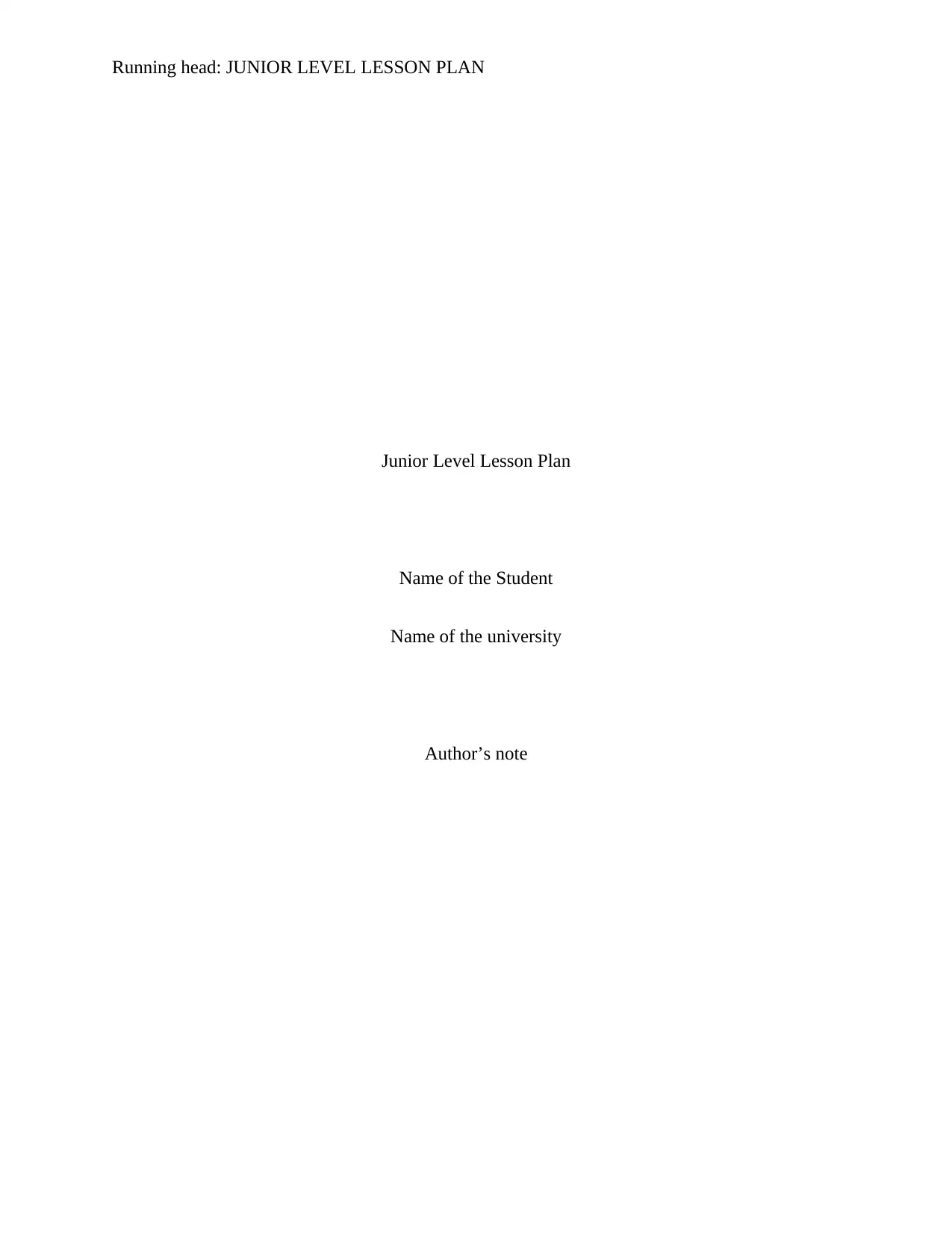
Running head: JUNIOR LEVEL LESSON PLAN
Junior Level Lesson Plan
Name of the Student
Name of the university
Author’s note
Junior Level Lesson Plan
Name of the Student
Name of the university
Author’s note
Paraphrase This Document
Need a fresh take? Get an instant paraphrase of this document with our AI Paraphraser
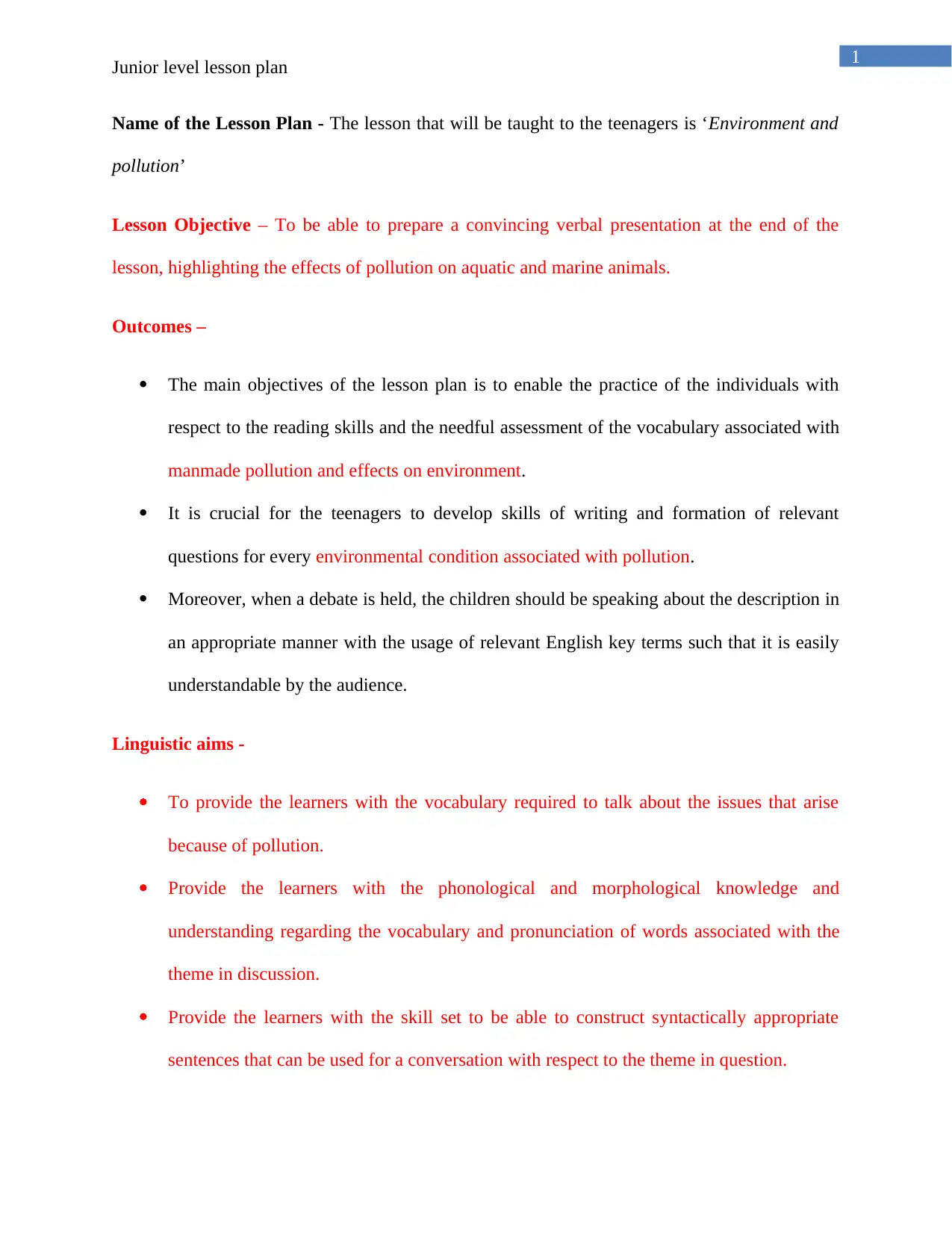
1
Junior level lesson plan
Name of the Lesson Plan - The lesson that will be taught to the teenagers is ‘Environment and
pollution’
Lesson Objective – To be able to prepare a convincing verbal presentation at the end of the
lesson, highlighting the effects of pollution on aquatic and marine animals.
Outcomes –
The main objectives of the lesson plan is to enable the practice of the individuals with
respect to the reading skills and the needful assessment of the vocabulary associated with
manmade pollution and effects on environment.
It is crucial for the teenagers to develop skills of writing and formation of relevant
questions for every environmental condition associated with pollution.
Moreover, when a debate is held, the children should be speaking about the description in
an appropriate manner with the usage of relevant English key terms such that it is easily
understandable by the audience.
Linguistic aims -
To provide the learners with the vocabulary required to talk about the issues that arise
because of pollution.
Provide the learners with the phonological and morphological knowledge and
understanding regarding the vocabulary and pronunciation of words associated with the
theme in discussion.
Provide the learners with the skill set to be able to construct syntactically appropriate
sentences that can be used for a conversation with respect to the theme in question.
Junior level lesson plan
Name of the Lesson Plan - The lesson that will be taught to the teenagers is ‘Environment and
pollution’
Lesson Objective – To be able to prepare a convincing verbal presentation at the end of the
lesson, highlighting the effects of pollution on aquatic and marine animals.
Outcomes –
The main objectives of the lesson plan is to enable the practice of the individuals with
respect to the reading skills and the needful assessment of the vocabulary associated with
manmade pollution and effects on environment.
It is crucial for the teenagers to develop skills of writing and formation of relevant
questions for every environmental condition associated with pollution.
Moreover, when a debate is held, the children should be speaking about the description in
an appropriate manner with the usage of relevant English key terms such that it is easily
understandable by the audience.
Linguistic aims -
To provide the learners with the vocabulary required to talk about the issues that arise
because of pollution.
Provide the learners with the phonological and morphological knowledge and
understanding regarding the vocabulary and pronunciation of words associated with the
theme in discussion.
Provide the learners with the skill set to be able to construct syntactically appropriate
sentences that can be used for a conversation with respect to the theme in question.
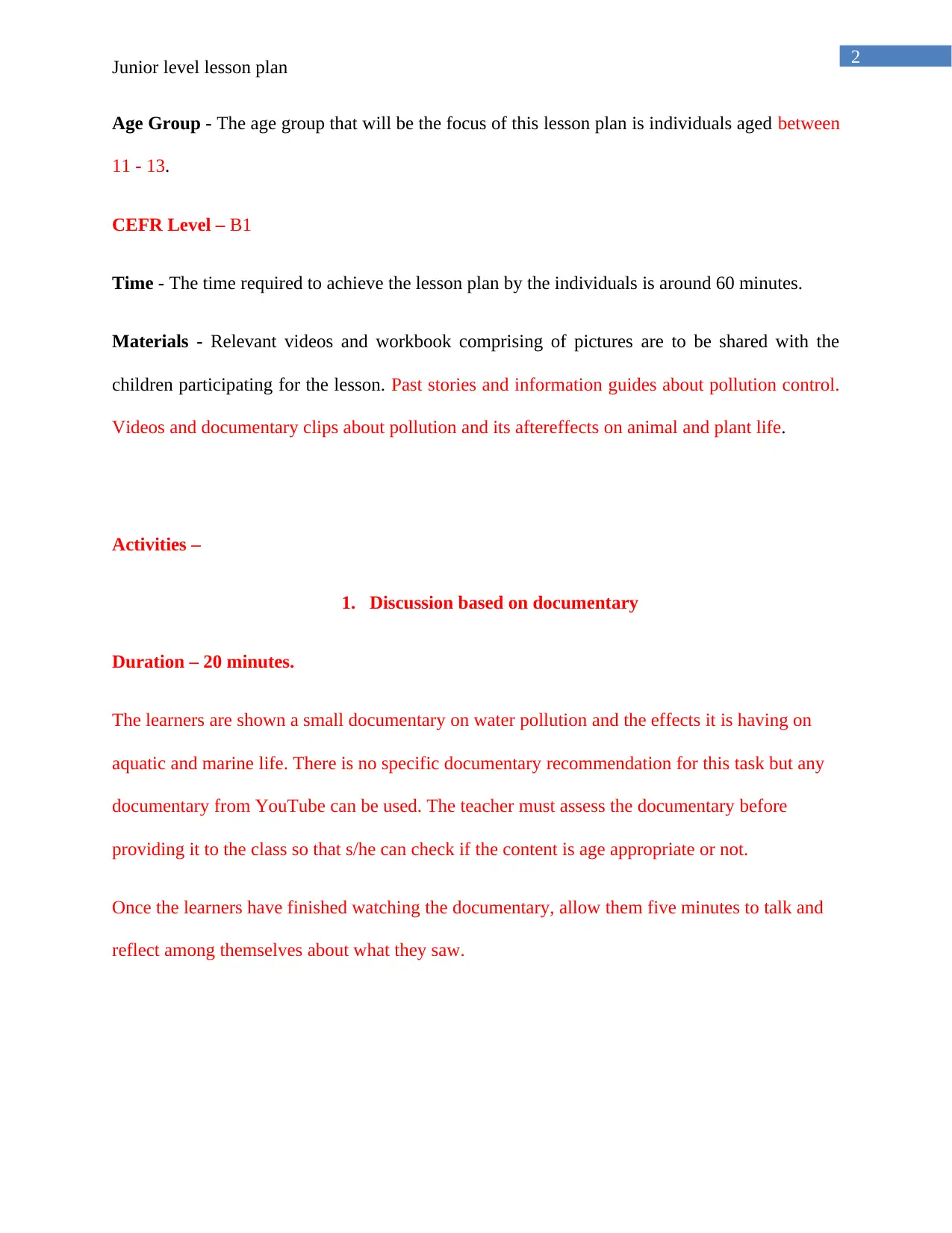
2
Junior level lesson plan
Age Group - The age group that will be the focus of this lesson plan is individuals aged between
11 - 13.
CEFR Level – B1
Time - The time required to achieve the lesson plan by the individuals is around 60 minutes.
Materials - Relevant videos and workbook comprising of pictures are to be shared with the
children participating for the lesson. Past stories and information guides about pollution control.
Videos and documentary clips about pollution and its aftereffects on animal and plant life.
Activities –
1. Discussion based on documentary
Duration – 20 minutes.
The learners are shown a small documentary on water pollution and the effects it is having on
aquatic and marine life. There is no specific documentary recommendation for this task but any
documentary from YouTube can be used. The teacher must assess the documentary before
providing it to the class so that s/he can check if the content is age appropriate or not.
Once the learners have finished watching the documentary, allow them five minutes to talk and
reflect among themselves about what they saw.
Junior level lesson plan
Age Group - The age group that will be the focus of this lesson plan is individuals aged between
11 - 13.
CEFR Level – B1
Time - The time required to achieve the lesson plan by the individuals is around 60 minutes.
Materials - Relevant videos and workbook comprising of pictures are to be shared with the
children participating for the lesson. Past stories and information guides about pollution control.
Videos and documentary clips about pollution and its aftereffects on animal and plant life.
Activities –
1. Discussion based on documentary
Duration – 20 minutes.
The learners are shown a small documentary on water pollution and the effects it is having on
aquatic and marine life. There is no specific documentary recommendation for this task but any
documentary from YouTube can be used. The teacher must assess the documentary before
providing it to the class so that s/he can check if the content is age appropriate or not.
Once the learners have finished watching the documentary, allow them five minutes to talk and
reflect among themselves about what they saw.
⊘ This is a preview!⊘
Do you want full access?
Subscribe today to unlock all pages.

Trusted by 1+ million students worldwide
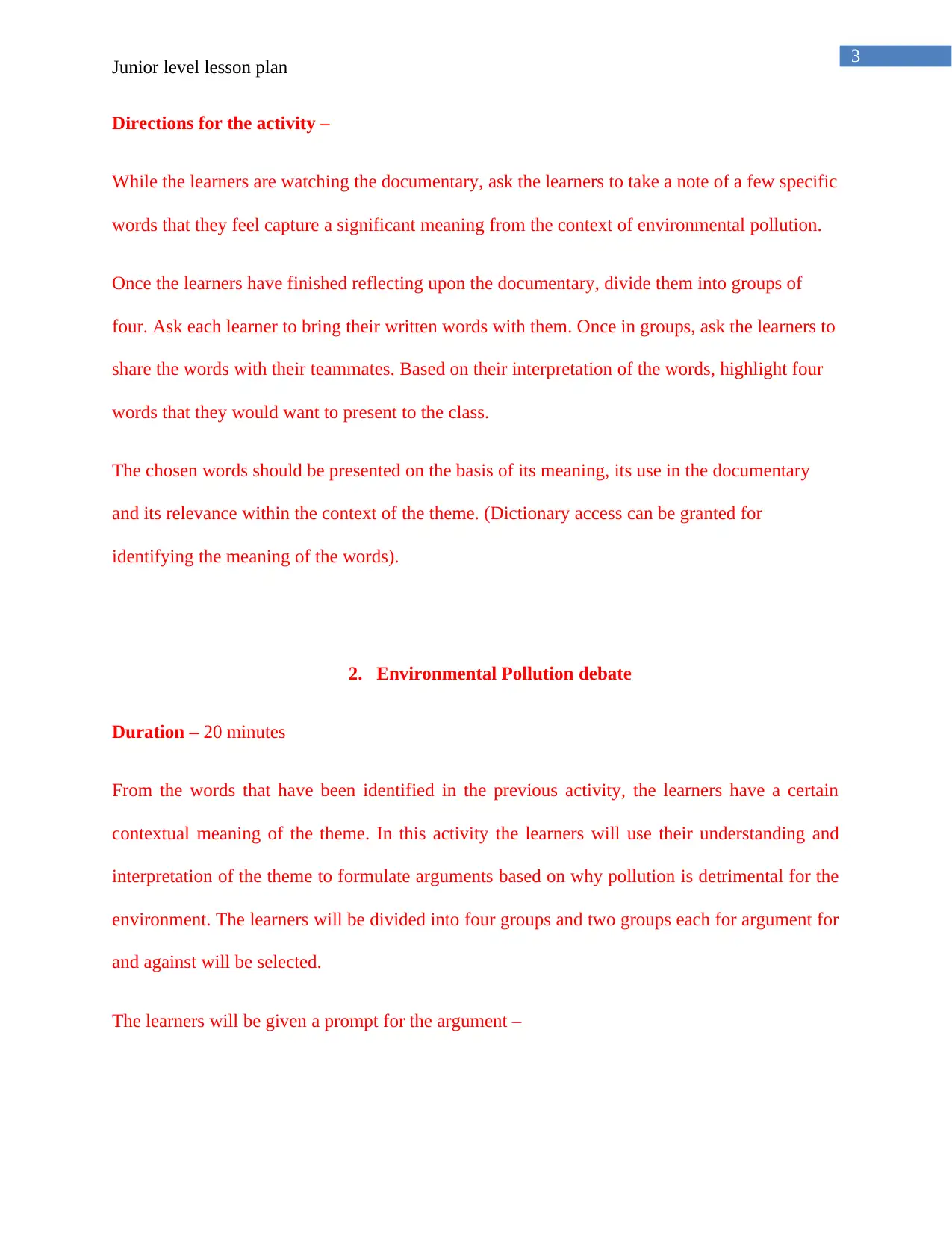
3
Junior level lesson plan
Directions for the activity –
While the learners are watching the documentary, ask the learners to take a note of a few specific
words that they feel capture a significant meaning from the context of environmental pollution.
Once the learners have finished reflecting upon the documentary, divide them into groups of
four. Ask each learner to bring their written words with them. Once in groups, ask the learners to
share the words with their teammates. Based on their interpretation of the words, highlight four
words that they would want to present to the class.
The chosen words should be presented on the basis of its meaning, its use in the documentary
and its relevance within the context of the theme. (Dictionary access can be granted for
identifying the meaning of the words).
2. Environmental Pollution debate
Duration – 20 minutes
From the words that have been identified in the previous activity, the learners have a certain
contextual meaning of the theme. In this activity the learners will use their understanding and
interpretation of the theme to formulate arguments based on why pollution is detrimental for the
environment. The learners will be divided into four groups and two groups each for argument for
and against will be selected.
The learners will be given a prompt for the argument –
Junior level lesson plan
Directions for the activity –
While the learners are watching the documentary, ask the learners to take a note of a few specific
words that they feel capture a significant meaning from the context of environmental pollution.
Once the learners have finished reflecting upon the documentary, divide them into groups of
four. Ask each learner to bring their written words with them. Once in groups, ask the learners to
share the words with their teammates. Based on their interpretation of the words, highlight four
words that they would want to present to the class.
The chosen words should be presented on the basis of its meaning, its use in the documentary
and its relevance within the context of the theme. (Dictionary access can be granted for
identifying the meaning of the words).
2. Environmental Pollution debate
Duration – 20 minutes
From the words that have been identified in the previous activity, the learners have a certain
contextual meaning of the theme. In this activity the learners will use their understanding and
interpretation of the theme to formulate arguments based on why pollution is detrimental for the
environment. The learners will be divided into four groups and two groups each for argument for
and against will be selected.
The learners will be given a prompt for the argument –
Paraphrase This Document
Need a fresh take? Get an instant paraphrase of this document with our AI Paraphraser
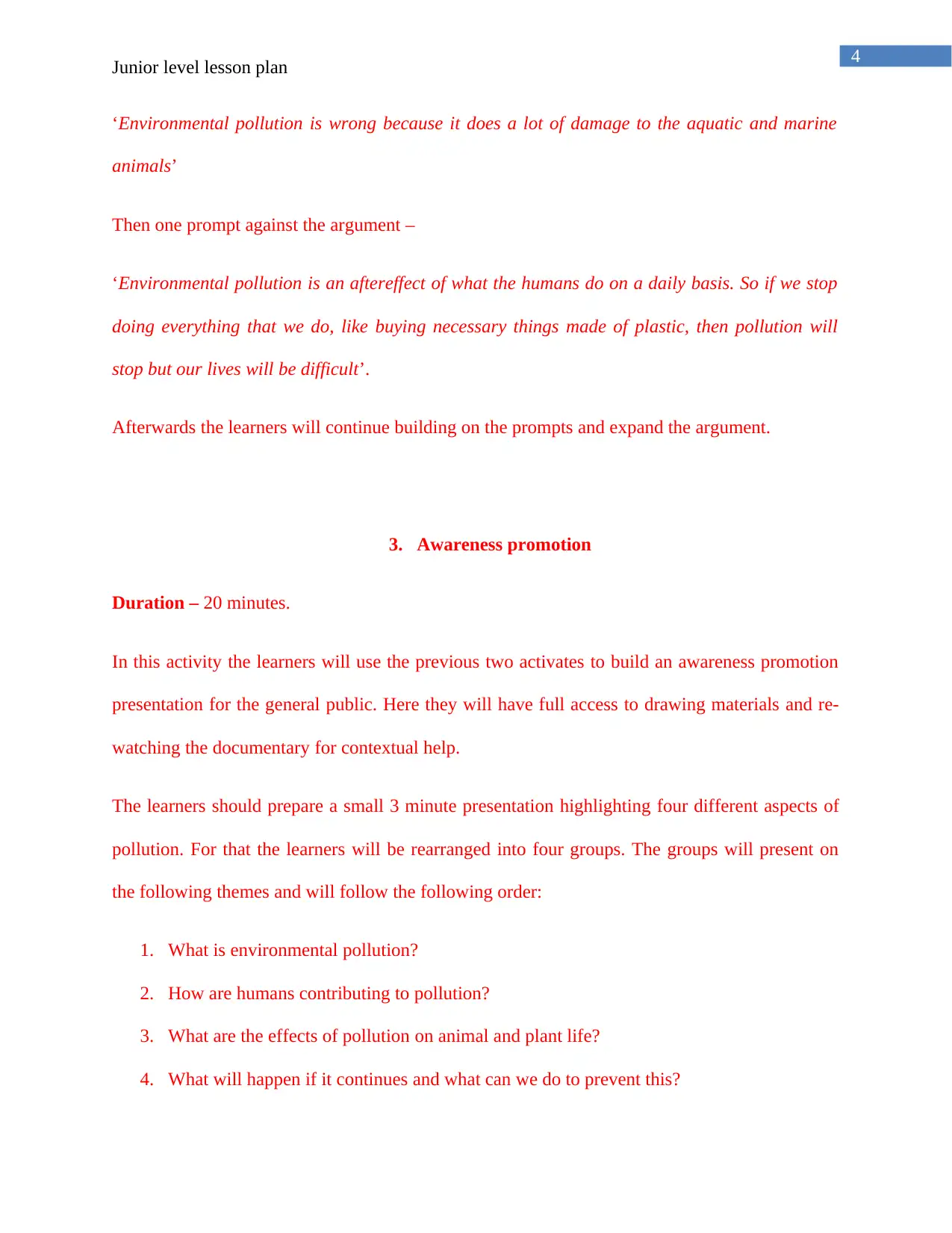
4
Junior level lesson plan
‘Environmental pollution is wrong because it does a lot of damage to the aquatic and marine
animals’
Then one prompt against the argument –
‘Environmental pollution is an aftereffect of what the humans do on a daily basis. So if we stop
doing everything that we do, like buying necessary things made of plastic, then pollution will
stop but our lives will be difficult’.
Afterwards the learners will continue building on the prompts and expand the argument.
3. Awareness promotion
Duration – 20 minutes.
In this activity the learners will use the previous two activates to build an awareness promotion
presentation for the general public. Here they will have full access to drawing materials and re-
watching the documentary for contextual help.
The learners should prepare a small 3 minute presentation highlighting four different aspects of
pollution. For that the learners will be rearranged into four groups. The groups will present on
the following themes and will follow the following order:
1. What is environmental pollution?
2. How are humans contributing to pollution?
3. What are the effects of pollution on animal and plant life?
4. What will happen if it continues and what can we do to prevent this?
Junior level lesson plan
‘Environmental pollution is wrong because it does a lot of damage to the aquatic and marine
animals’
Then one prompt against the argument –
‘Environmental pollution is an aftereffect of what the humans do on a daily basis. So if we stop
doing everything that we do, like buying necessary things made of plastic, then pollution will
stop but our lives will be difficult’.
Afterwards the learners will continue building on the prompts and expand the argument.
3. Awareness promotion
Duration – 20 minutes.
In this activity the learners will use the previous two activates to build an awareness promotion
presentation for the general public. Here they will have full access to drawing materials and re-
watching the documentary for contextual help.
The learners should prepare a small 3 minute presentation highlighting four different aspects of
pollution. For that the learners will be rearranged into four groups. The groups will present on
the following themes and will follow the following order:
1. What is environmental pollution?
2. How are humans contributing to pollution?
3. What are the effects of pollution on animal and plant life?
4. What will happen if it continues and what can we do to prevent this?

5
Junior level lesson plan
The learners will be given time to prepare their presentation and present them in the class in the
aforementioned order.
Junior level lesson plan
The learners will be given time to prepare their presentation and present them in the class in the
aforementioned order.
⊘ This is a preview!⊘
Do you want full access?
Subscribe today to unlock all pages.

Trusted by 1+ million students worldwide
1 out of 6
Your All-in-One AI-Powered Toolkit for Academic Success.
+13062052269
info@desklib.com
Available 24*7 on WhatsApp / Email
![[object Object]](/_next/static/media/star-bottom.7253800d.svg)
Unlock your academic potential
Copyright © 2020–2025 A2Z Services. All Rights Reserved. Developed and managed by ZUCOL.


